The Irishmen who fought with Custer at the little Big Horn
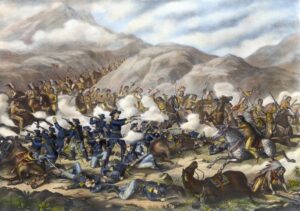
By John Joe McGinley
The battle of Little Big Horn, also known to the Lakota Sioux and other Native Americans as the battle of Greasey Grass, is usually referred to as Custer’s Last Stand.
On the two fateful and bloody days of the 25th and 26th June 1876 Native Americans from the Lakota, Northern Cheyenne and Arapaho tribes inflicted a significant defeat on the United States Army’s iconic 7th Cavalry, led by the most flamboyant and famous soldier of his age, Lieutenant Colonel George Armstrong Custer. (1)
As the 7th Cavalry rode into battle, the 600 men under Custer’s command included 103 Irishmen and 34 of those would die on the battlefield with their commander.
Irish service in the US military
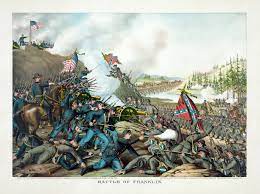
Since their formation Irishmen have played a pivotal role in the American armed forces.
At the battle of Lexington on April 19th, 1776, when 400 minutemen and revolutionary militia drove back the British at the Old North Bridge and began the American War of independence over 100 Irishmen were in their ranks. (2)
As the American nation grew, Irishmen fought and died in every major battle and conflict. To many Irish immigrants the military offered an escape route out of poverty and anti-Catholic prejudice. It provided a secure employment and 3 meals a day.
It’s estimated that up to 200,000 Irish Americans fought in the American Civil War, with 150,000 on the Union side and approximately 30,000-40,000 on the Southern Confederacy side.
Over 200,000 Irishmen served in the American Civil War, 1861-1865 and they comprised 21% of the post-war US army.
Many joined of their free will, as they fully accepted America as their new homeland, but others were forcibly drafted into service by the controversial Enrolment Act of March 3rd, 1863. Irish the immigrant soldiers incorporated their own national identity into the ranks of many of the units in which they served. From the Union Army’s Irish Brigade to the 24th Georgia Volunteer Infantry and Louisiana Tigers on the Confederacy side, which were heavily Irish influenced.
At the end of the civil war thousands of men found themselves unemployed as the peace time army scaled back. However, as America looked to exploit the west men were now needed to fight the native Americans who stood in the way of expansion. The immigrant Irish were once again attracted to the soldier’s life.
For many Irish men , the prospect of the Army’s poor pay, and conditions would be balanced by the opportunity to acquire land and a fresh start beyond the ever-more crowded cities and Eastern states.
Close to 47 percent of the men recruited by the Regular Army between the end of the Civil War and the Battle of the Little Bighorn were foreign-born. The Irish provided the largest contingent of these, with 38,649 or 21% of all enlistees, over that 11-year period. The US Army was once again marching to an Irish beat (3)
The Irish influence in the 7th Cavalry
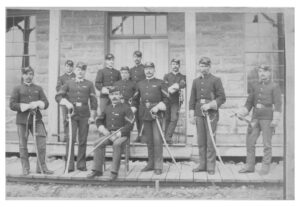
The main military focus of the expansion westward expansion were the newly formed regiments of horse soldiers, the most famous of which would become the 7th U.S. Cavalry.
Its fame, derived from one of its commanders, the flamboyant civil war hero, George Armstrong Custer. Dubbed the “Boy General” after his rapid rise through the ranks of the Union cavalry.
The cavalry regiments were primarily allocated a policing role, protecting settlers and traders along emerging migratory routes that crossed into lands traditionally occupied by the Native American tribes. Frontier life was a difficult posting for the Irish soldiers who manned the new forts that sprung up all along the western frontier.
Most Irish soldiers experienced a life that was hard and often monotonous. The majority of the men saw little or no combat and spent long days in routine manual labour and subjected to sometimes cruel discipline.
Most Irish soldiers experienced a life that was hard and often monotonous. but, for poor and uneducated immigrants, enlistment offered opportunities.
However, for the poor and uneducated, enlistment offered better opportunities for recent immigrants than they could find in the civilian world. They learned about obedience, self-reliance, cleanliness and other virtues that would help in life after the Army. (4)
Not only were some of his best and most colourful soldiers Irish, they also provided a large proportion of the non-commissioned officers in the 7th Cavalry . Sergeants Michael Kenney from Galway and Michael Martin from Dublin were two of the highest-ranking. There were also 15 sergeants and three corporals from Ireland who rode into battle with Custer on that fateful day in 1876. Custer’s trademark buckskin outfit was also made by an Irish tailor (Sergeant Jeremiah Finley from Tipperary). (5)
The only Irish Officer in the 7th Cavalry was Myles Walter Keogh the son of middle-class Catholic farmers from county Carlow whose military adventures first started on the continent of Europe and would end on the plains of Little Big Horn.
Myles Walter Keogh Knight of the Order of St Gregory the Great and civil war hero
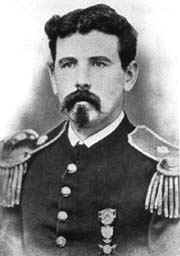
Myles Walter Keogh had a short life but one that was filled with adventure. He first served with the armies of the Papal States during the war for Italian unification, he then rose to the rank of Lieutenant Colonel in the union army during the American civil war.
He was born in Orchard House, Leighlinbridge, county Carlow, on 25th March 1840. His family owned a successful farm, and he was one of 12 children born to his parents. His first adventure began in 1860 when the heeded the plea for Catholics to come to the defence of the Papal States against the Italian nationalist forces of Garibaldi who sought to unify the Italian peninsula.
Despite the swift defeat of the papal forces, he was one of only 50 Irish veterans to join the Papal bodyguard’s newly created Company of St Patrick. He was awarded both the Pro Petri Sede medal for Gallantry and made a Knight of the Order of St Gregory the Great. (6)
The life of a ceremonial bodyguard proved far too tedious for Keogh, however, and with civil war raging in America his eyes looked across the Atlantic.
Myles Keogh fought in the Wars of Italian Unification, the American Civil War and died at the Little Big Horn alongside Custer.
In February 1862 Keogh resigned his commission in the company of Saint Patrick and set sail for New York. On his arrival, he was given the rank of Captain and assigned to the staff of Brigadier General James Shields a fellow Irishman and tenacious fighter who had been given the remit to seek and destroy the Confederate Army of Stonewall Jackson.
On June 9th, 1863, now an experienced cavalryman, Keogh took part in the battle of Brandy Station the largest cavalry engagement ever to take place on US soil.
In July 1863, his bravery at the battle of Gettysburg saw him receive promotion to the rank of major for “gallant and meritorious services”. (7) However, he spent two and half months as a prisoner of war before being released in an exchange arranged by Union General William Tecumseh Sherman.
Keogh went straight back into battle on his release and was promoted once again to lieutenant colonel for his gallantry during the battle of Dallas in June 1864.
He ended the war as ‘Brevet’ Lieutenant Colonel and chose to remain on active duty accepting a commission as a Second Lieutenant in the 4th Cavalry on 4th May 1866.
On 28th July 1866 he was promoted to Captain and reassigned to the 7th Cavalry at Fort. Riley in Northeast Kansas where he took command of Company I.
Mounting Tensions
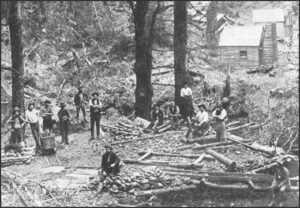
The Battle of Little Big Horn has its roots in the 1875 discovery of gold in the Black Hills of South Dakota. This led to an influx of settlers seeking their fortune, which broke the Second Fort Laramie Treaty. The US government did nothing to stop the prospectors.
The US government offered to buy the Black Hills from the Native Americans, As this was sacred land, they refused.
Sioux warriors began attacking the miners and other settlers. The US Army was sent to the area to protect the settlers, and to force the Sioux and Cheyenne back to their reservations.
The Battle of Little Big Horn has its roots in the 1875 discovery of gold in the Black Hills of South Dakota
In December 1875, Sioux and Cheyenne Native Americans refused an order from the US government to return to their reservations. Instead, they joined Sitting Bull and Crazy Horse in Montana.
Sitting Bull and Crazy Horse leaders of the Lakota Sioux nation on the Great Plains, strongly resisted the efforts of the US Government to confine their people to unsuitable reservations.
By the late spring of 1876, more than 10,000 Native Americans had gathered in a camp along the Little Bighorn River
When a federal deadline to move to reservations expired, Custer and his 7th Cavalry, was part of a US force dispatched to confront them.
Preparing for Battle
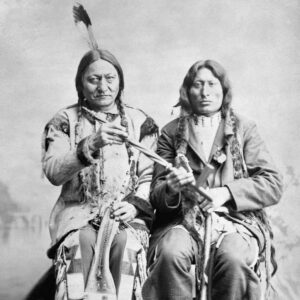
The U.S. Army dispatched three columns of soldiers, including Custer and his 7th Cavalry, to force sitting Bull and his people back to their reservations.
The plan was for Custer’s cavalry and Brigadier General Alfred Terry’s infantry to rendezvous with troops under the command of Colonel John Gibbon and Brigadier General George Crook. They would then seek out the Native Americans, surround them and force their surrender.
Crook was delayed but Terry, Custer and Gibbon met-up in mid-June and after a scouting party found a trail headed toward Little Big Horn Valley, they decided Custer should move in, surround the Native Americans, but not attack and await reinforcements.
Custer pressed home an attack with small and divided cavalry force against a much larger Sioux and Cheyanne force.
Custer stubbornly forged ahead, but things did not go as planned. Around midday on Sunday June 25th, 1876, his scouts located Sitting Bull’s camp near the Little Bighorn River in Montana Territory. After encountering a nearby group of around forty warriors, Custer and his men attacked them before they could alert the main party. Instead of waiting for reinforcements, Custer decided to attack the village, However, he was unaware that the Native American warriors now vastly outnumbered him. (8)
The Sioux and Cheyanne, knowing the attack was imminent prepared to fight. Sitting Bull rallied the warriors and saw to the safety of the women and children, while Crazy Horse set off with a large force to face the soldiers head on.
The Battle of Little Big Horn
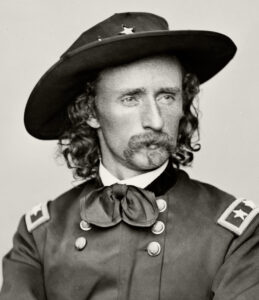
Those who have watched the many films that have depicted the Battle of the Little Bighorn, such as ‘They died with their boots on’ starring Errol Flynn, would be forgiven if you assumed the battle was one calamitous collision of two opposing forces.
The reality is that it was a series of engagements, running fights, standoffs and encirclements stretching over five miles from what is today known as Reno Hill to Custer’s own Last Stand Hill.
These are both high points at opposite ends of a string of bluffs overlooking the Little Bighorn River in Montana.
Unaware of the numbers about to face him Custer divided his more than 600 men into four groups. He ordered one small battalion to stay with the supply train and the other two, led by Captain Frederick Benteen and Major Marcus Reno, to attack from the south and prevent the Indians from escaping. Custer would lead the final group of 210 men and attack from the north. (9)
Reno’s group attacked first but swiftly embarked on a disorganized retreat after discovering they were completely outnumbered. By the time they had regrouped, at least 30 troops were dead.
The Sioux and Cheyenne crossed the river together, meeting the advancing soldiers and forcing them back. Benteen’s troops came to Reno’s aid and the combined battalions joined forces on what is now known as Reno Hill. They remained there despite Custer’s order:
“Benteen. Come on, Be quick, Bring packs” (10)
34 of the 268 US soldiers killed were Irish born.
At the same time another Native American force, commanded by Crazy Horse, surrounded Custer and his men. They began the attack with heavy gun- and arrow-fire.
As the Native Americans closed in on Custer, he ordered his men to shoot their horses, and stack their bodies up to form a protective barrier. This, however, did little to protect his troops from the enemy bullets and the mass of Native American warriors who vastly outnumbered Custer and his men.
Custer and all his men were killed in less than an hour.
Reno and Beenteen fought on through the night and into the next day. They were unaware of what had happened to Custer and his men until they were relieved by General Terry on the 27th of June.
The total U.S. casualty count included 268 dead and 55 severely wounded (six died later from their wounds) (11)
Some of the Irish that died
34 Irish-born members of the 7th Cavalry perished, the most prominent being Myles Keogh, who was later buried in upstate New York.
Keogh may have had a premonition of his death as he had organised his will and purchased life insurance before the campaign began. He was the only Irish officer to take part in the Battle of the Little Bighorn and apparently one of the last to fall.
When the defeat was discovered and the sun-blackened and dismembered dead were buried three days later, Keogh’s body was found at the centre of a group of troopers that included his two sergeants and company trumpeter. His body was stripped but not mutilated, perhaps because of the “medicine” seen in the Agnus Dei (“Lamb of God”) he wore on a chain about his neck. (12)
Keogh’s left knee had been shattered by a bullet that corresponded to a wound through the chest and flank of his horse, indicating that horse and rider may have fallen together prior to the last rally.
His horse, Comanche, was the only injured animal the rescue party spared, and after he was nursed back to health, was adopted as the regimental mascot of the 7th Cavalry which he remained until his death in 1890.
Private Thomas Downing was 20 years old but already the father of a child back in Iowa. He was attached to Myles Keogh’s Company 1. Downing was killed on Calhoun Hill, a position named after Lieutenant James Calhoun, Custer’s brother-in-law.
Privates Patrick Golden and Richard Farrell died at opposite ends of the battlefield. Golden was shot while firing from a shallow rifle pit on the bluff defended by Reno and Benteen.
Farrell died in a ravine at the other end of the battlefield, close to where Custer was found.
Sergeant Robert Hughes had the ultimately dubious honour of carrying Custer’s personal flag, or guidon. As such, he was a particularly prominent target whose fate was quickly sealed.
Sergeant Jeremiah Finley the soldier tailor who had made Custer’s famous buckskin Jacket was found dead beside his horse, both riddled with arrows.
The terrible aftermath for the Native Americans
Despite their victory at the battle of the Little Big Horn once news spread that more than 260 US soldiers had been killed, public opinion quickly turned against the Native Americans.
The U.S. Army intensified their efforts to hunt down all resisting Native Americans and either wipe them out or force them back onto reservations. Within a year, most had been rounded up or killed.
Within a year of their victory over Custer, most Sioux and Cheyanne were forcibly confined to reservations.
Native Americans had to stay on their reservations. Any found outside their reservations were pursued by the army and killed. By the early 1880s, almost all Cheyenne and Sioux were confined to reservations, totally dependent on the US government for food and shelter.
Previous treaties were now ignored. The US government decided that Native Americans had forfeited the rights to have any special treatment and started to eliminate Native American culture. The Sioux were forced to sell the Black Hills, and their reservations were split up.
To prevent any future Sioux attacks, their weapons and horses were taken. New forts were built, and the number of soldiers in the area increased.
In May 1877, Crazy Horse surrendered at Fort Robinson, Nebraska, where he was later bayoneted and killed after an altercation with an army officer. After fleeing to Canada, Sitting Bull eventually surrendered in 1881 and lived on Standing Rock Reservation until he was killed by Native American agent policemen during a conflict at his house in 1890. (13)
Irish survivors of the battle
Sixty nine Irish soldiers survived the battle. Daniel Newell from County Roscommon fought with Major Reno and was among the troopers who initially attacked the Native American village where he was shot in the left thigh. He managed to fight his way with Reno to the high ground and was besieged for two days. Daniel recovered from his wounds and eventually settled in Sturgis South Dakota where he became a blacksmith. He was one of the few survivors to attend the fiftieth anniversary commemoration of the Battle of the Little Big Horn in 1926.
Thomas Joseph Callan from county Lough a 23-year-old private who had only joined the regiment 3 month before the battle was awarded the Medal of Honour for:
“Volunteered and succeeded in obtaining water for the wounded of the command; also displayed conspicuously good conduct in assisting to drive away the enemy”. (14)
The Battle of The Little Big Horn was testimony to Custer’s arrogance and over confidence but as in many battles before and many more after, Irish men fought and died in the ranks of the US Army, and we remember those who fell 146 years ago.
John Joe McGinley June 2021
Sources:
- Battle of the Greasy Grass: Smithsonian Magazine December 2014
- Paul Revere’s Ride David Hackett (1994
- The Wild Geese January 2013
- The Great Plains Guide to Custer Jeff Barnes 2011
- The Last Stand: Custer, Sitting Bull, and the Battle of the Little Big Horn Nathaniel Philbrick Viking, 2010
- Myles Keogh: The Life and Legend of an “Irish Dragoon” in the Seventh Cavalry, John P. Langellier, Kurt Hamilton Cox, Brian C. Pohanka, 1998,
- Myles Keogh: The Life and Legend of an “Irish Dragoon” in the Seventh Cavalry, John P. Langellier, Kurt Hamilton Cox, Brian C. Pohanka, 1998,
- com Annette McDermott
- com Annette McDermott
- The Old West Soldiers David Nevin 1973
- Archaeological Perspectives on the Battle of the Little Bighorn Douglas D Scott, (2013).
- Myles Keogh: The Life and Legend of an “Irish Dragoon” in the Seventh Cavalry, John P. Langellier, Kurt Hamilton Cox, Brian C. Pohanka, 1998,
- com Annette McDermott
- com
Full list of the Irish who died at Little Big Horn
Atcheson, Thomas – 41 – Private – F – Antrim
Barry, John – 27 – Private – I – Waterford
Boyle, Owen – 33 – Private – E – Waterford
Bruce, Patrick – 31 – Private – F – Cork
Bustard, James – 30 – Sergeant – I – Donegal
Carney, James – 33 – Private – F – Westmeath
Cashan, William – 31 – Sergeant – L – Queen’s (Laois)
Connor, Edward – 30 – Private – E – Clare
Considine, Martin* – 28 – Sergeant – G – Clare
Cooney, David 28 – Private – I – Cork
Downing, Thomas P – 24 – Private – I – Limerick
Drinan, James* – 23 – Private – A – Cork
Driscoll, Edward C – 25 – Private – I – Waterford
Farrell, Richard – 25 – Private – E – Dublin
Finley, Jeremiah– 35 – Sergeant – C – Tipperary
Golden, Patrick M*– 26 – Private – D – Sligo
Graham, Charles – 39 – Private – L – Tyrone
Griffin, Patrick – 28 – Private – C – Kerry
Hagan (Eagan), Thomas P – 28 – Corporal – E – Not known
Henderson, John – 37 – Private – E – Cork
Hughes, Robert H – 36 – Sergeant – K – Dublin
Kavanagh, Thomas – 31 – Private – L – Dublin
Kelley, Patrick – 35 – Private – I – Mayo
Kenney, Michael – 26 – 1st Sergeant – F – Galway
Keogh, Myles Walter – 36 – Captain – I – Carlow
McElroy, Thomas – 31 – Trumpeter – E – Not known (
McIlhargey, Archibald – 31 – Private – I – Antrim (
Mahoney, Bartholomew – 30 – Private – L – Cork
Martin, James* – 28 – Corporal – G – Kildare
Mitchell, John Edward – 34 – Private – I – Galway
O’Connell, David J – 32 Private – L – Cork
O’Connor, Patrick Edward – 25 – Private – E – Longford
Smith, James – 34 – Private – E – Tipperary
Sullivan, John – 25 – Private – A – Dublin
Donnelly, Timothy – 19 – Private – F – County Durham, England (of Irish Catholic parents thought to be from County Roscommon) – 5’6″, blue eyes, dark hair, fair complexion, almost certainly would have considered himself to be Irish.
Source: Menwithcuster.com